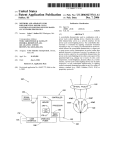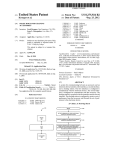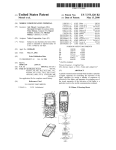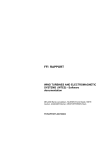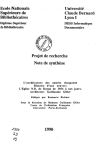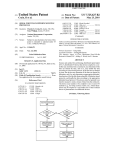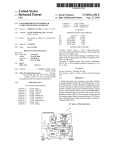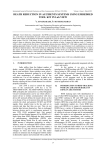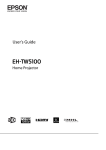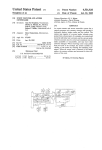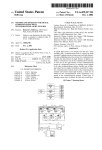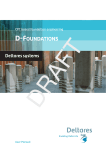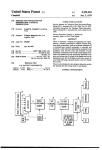Download Systems and methods for synchronizing lighting effects
Transcript
US007449847B2 (12) United States Patent Schanberger et a]. (54) US 7,449,847 B2 (10) Patent N0.: (45) Date of Patent: SYSTEMS AND METHODS FOR SYNCHRONIZING LIGHTING EFFECTS Nov. 11, 2008 (51) Int. Cl. H05B 37/00 (52) US. Cl. ..................... .. 315/312; 315/317; 315/362; (58) Field of Classi?cation Search ............... .. 315/194, (2006.01) (75) Inventors: Eric K. Schanberger, Cambridge, MA 315/360; 362/227; 362/236 (US); Kevin J. DoWling, Westford, MA 315/291, 292, 294, 295, 312, 313, 317, 362, 315/360; 362/234, 227, 236; 323/235, 237 (Us) (73) Assignee: Philips Solid-State Lighting Solutions, See application ?le for complete search history. Inc., Burlington, MA (U S) (*) Notice: (56) References Cited Subject to any disclaimer, the term of this patent is extended or adjusted under 35 U.S. PATENT DOCUMENTS 2,848,671 A USC 154(b) by 874 days. 8/1958 McDonald (21) Appl. N0.: 10/915,947 (22) Filed: (65) (Continued) FOREIGN PATENT DOCUMENTS Aug. 11, 2004 AU Prior Publication Data US 2005/0035728 A1 6 267 9 Feb. 17, 2005 (Continued) Related US. Application Data (63) 12/1996 OTHER PUBLICATIONS Continuation of application No. 10/ 143,549, ?led on May 10, 2002, noW Pat. No. 6,801,003, and a continu *“LMl 17/LM317NLM317 3-Terminal Adjustable Regulator”, National Semiconductor Corporation, May 1997, pp. 1-20. ation-in-part of application No. 10/040,253, ?led on (Continued) Oct. 25, 2001, noW Pat. No. 6,781,329, and a continu ation-in-part of application No. 10/040,291, ?led on Primary ExamineriHaissa Philogene Oct. 25, 2001, noW Pat. No. 6,936,978, and a continu (74) Attorney, Agent, or FirmiWolf, Green?eld & Sacks, ation-in-part of application No. 10/040,292, ?led on Oct. 25, 2001, and a continuation-in-part of applica RC. tion No. 10/040,266, ?led on Oct. 25, 2001, noW Pat. (57) ABSTRACT No. 6,774,584, and a continuation-in-part of applica tion No. 10/045,629, ?led on Oct. 25, 2001, noW Pat. No. 6,967,448, and a continuation-in-part of applica tion No. 10/040,252, ?led on Oct. 25, 2001, noW Pat. ing lighting effect generated by the lighting apparatus; No. 6,869,204, and a continuation-in-part of applica Wherein the processor is further con?gured to monitor an operating poWer source; and Wherein the processor is further tion No. 09/805,368, ?led on Mar. 13, 2001, noW Pat. (60) In one example, a lighting apparatus comprises a processor Wherein the processor is con?gured to control a color-chang No. 7,186,003, and a continuation-in-part of applica con?gured to synchronize the color-changing lighting effect tion No. 09/805,590, ?led on Mar. 13, 2001, noW Pat. in coordination With a parameter of the operating poWer No. 7,064,498. Provisional application No. 60/290,101, ?led on May 10, 2001. source. 42 Claims, 3 Drawing Sheets /114 118 \ MEMORY USER INTERFACE 100 / A/12a 102 104A —— TIMING CIRCUIT LED PROCESSOR 132 104B’ LED — LED POWER MONITOR —RED _ GREEN —BLUE 1040 1J0 COM PORT 124 SENSOR \122 US 7,449,847 B2 Page2 U.S. PATENT DOCUMENTS 2,909,097 3,104,815 3,318,185 3,561,719 3586936 3,601,621 3,643,088 3,746,918 3,818,216 3,832,503 3,845,291 3,858,086 3,909,670 3,924,120 3,958,885 3,967,170 3,974,637 4,001,571 4,054,814 4,082,395 4,096,349 4,241,295 4,272,689 4,273,999 4,298,869 4,305,117 4,317,071 4,329,625 4,367,464 4,388,567 4,388,589 4,392,187 A A A A A A A A A A A A A A A A A A A A A A A A A A A A A A A A 4,394,716 A 4,396,871 4,420,711 4500796 4,564,889 4,616,298 A A A A A 10/1959 9/1963 5/1967 2/1971 6/1971 8/1971 2/1972 7/1973 6/1974 8/1974 10/1974 12/1974 9/1975 12/1975 5/1976 6/1976 8/1976 V1977 10/1977 4/1978 6/1978 12/1980 6/1981 6/1981 11/1981 12/1981 2/1982 5/1982 1/1983 6/1983 6/1983 7/1983 Alden et al. Schultz Kort Grindle McLeroy Ritchie Osteen eta1~ Druckeretal Larraburu Crane Portyrata Andersonetal. Wakamatsu etal. COX,IH Stockinger et al. MacDonald Bergey etal Martin Fegleyetal Donato et a1. Donato Williams, Jr. Crosbyet 91 Pierpoint Okuno Evans Murad NishiZaWaetal. Kurahashiet al. Yamazaki eta1~ MolldremllrBornhorst 7/1983 Campagnaetal. 8/1983 12/1983 2/1985 1/1986 10/1986 Scheuermann Takahashietal. QuiI1 Bolson Bolson 4,874,320 4,887,074 4,920,465 4,922,154 4,934,852 4,962,687 4,965,561 4,973,835 4,975,629 4,979,081 4,980,806 4,992,704 5,003,227 5,008,595 5,010,459 5,027,262 5,034,807 5,072,216 5,078,039 5,083,063 5,117,233 5,122,936 5,126,634 5,128,595 5,134,387 5,142,199 5,154,641 5,164,715 5,171,429 5,184,114 5,194,854 5,209,560 5,225,765 5,226,723 A A A A A A A A A A A A A A A A A A A A A A A A A A A A A A A A A A 10/1989 12/1989 4/1990 5/1990 6/1990 10/1990 10/1990 11/1990 12/1990 12/1990 12/1990 2/1991 3/1991 4/1991 4/1991 6/1991 7/1991 12/1991 1/1992 1/1992 5/1992 6/1992 6/1992 7/1992 7/1992 g/1992 10/1992 11/1992 12/1992 2/1993 3/1993 5/1993 7/1993 7/1993 Freed etal. Simon etal. Sargent Cacoub Havel Belliveau etal. Havel Kurosu etal. Callahan etal. Leach etal. Tayloretal. Stinson Nilssen Kazar Tayloret 31‘ Freed Von Kohom Grange Tulk etal. Brooks Hamosetal. Guthrie Johnson Ham Smith etal. Elwell McLaughlin Kashiwabara etal. Yasuo Brown Havel Tayloretal. Callahan etal. Chen 5,254,910 A 10/1993 Yang 5,256,948 5,267,129 5,282,121 5,294,865 5,301,090 10/1993 11/1993 1/1994 3/1994 4/1994 A A A A A Boldin etal. Anderson Bornhorstetal. Haraden Hed 4,617,498 A 10/1986 Ruppert 5,307,295 A 4/1994 Taylor etal. 4,622,881 4,625,152 4,633,161 4,635,052 4647217 4656398 4,668,895 11/1986 11/1986 12/1986 V1987 3/1987 4/1987 5/1987 5,319,301 5,329,431 5350977 5,357,170 5,371,618 5,374,876 5,388,357 6/1994 Callahan etal. 7/1994 Tayloretal. A A A A A A A Rand Nakai Callahan et al. Aoike etal Havel Michael er 91Schneiter A A A A A A A 9/1994 10/1994 12/1994 12/1994 2/1995 Hamamoto etal‘ Luchaco etal. Tai etal. Horibata etal. Mama 4,675,575 A 6/1987 Smith etal. ............ .. 315/185S 5,402,702 A 4/1995 4,682,079 A 7/1987 Sanders er 91 5,404,282 A 4/1995 Klinke etal. 4,686,425 4,687,340 4,688,154 4,688,869 4,695,769 4,701,669 4,704,660 4,705,406 4,707,141 4,727,289 4,740,882 4,753,148 4,771,274 4,780,621 4,780,917 4,818,072 4,823,069 4,837,565 4,843,627 4,844,333 4,845,481 4,845,745 4,863,223 A A A A A A A A A A A A A A A A A A A A A A A 8/1987 8/1987 8/1987 8/1987 9/1987 10/1987 11/1987 11/1987 11/1987 2/1988 4/1988 6/1988 9/1988 10/1988 11/1988 4/1989 4/1989 6/1989 6/1989 7/1989 7/1989 7/1989 9/1989 Havel Havel Nilssen Kelly Schweickardt Headet al. Robbins Havel Havel Uchida Miller Johnson Havel Bartleuccietal. Hancock Mohebban Callahan et al. White Stebbins Davis Havel Havel Weissenbach etal. 5,406,176 5,410,328 5,412,284 5,412,552 5,420,482 5,421,059 5,432,408 5,436,535 5,455,490 5,461,188 5,463,280 5,465,144 5,489,827 5,491,402 5,504,395 5,530,322 5,539,624 5,545,950 5,561,346 5,569,371 5,575,459 5,575,554 5,592,051 A A A A A A A A A A A A A A A A A A A A A A A 4/1995 4/1995 5/1995 5/1995 5/1995 6/1995 7/1995 7/1995 10/1995 10/1995 10/1995 11/1995 2/1996 2/1996 4/1996 6/1996 7/1996 8/1996 10/1996 10/1996 11/1996 11/1996 1/1997 Ham Sugden Yoksza etal. Moore etal. Fernandes Phares Leffersplr‘ Matsuda etal. Yang Callahan etal. Drago etal. Johnson Parkeretal. Xia Small Johnson etal. Ference etal. Dougheny Cho Byme Perling Anderson Guritz Korkala US 7,449,847 B2 Page 3 5,629,607 5,640,061 5,642,129 5,661,645 5,672,941 5,673,059 5,701,058 5,721,471 5,725,761 5,734,590 5,751,118 5,752,766 5,769,527 5,803,579 5,808,689 5,821,695 5,821,703 5,823,431 5,848,837 5,850,126 5,851,063 5,852,658 RE36,030 5,859,508 5,896,010 5,912,653 5,924,784 5,927,845 5,946,209 5,952,680 5,959,547 5,963,185 5,974,553 6,002,216 6,008,783 6,016,038 6,018,237 6,021,960 6,025,550 6,030,108 6,031,343 6,036,333 6,068,383 6,072,280 6,095,661 6,097,352 6,127,783 6,132,072 6,135,604 6,150,774 6,166,496 6,175,201 6,183,086 6,184,628 6,196,471 6,211,626 6,215,409 6,250,774 6,252,358 6,292,901 6,340,868 6,379,025 5/1997 6/1997 6/1997 8/1997 9/1997 9/1997 12/1997 2/1998 3/1998 3/1998 5/1998 5/1998 6/1998 9/1998 9/1998 10/1998 10/1998 10/1998 12/1998 12/1998 12/1998 12/1998 1/1999 1/1999 4/1999 6/1999 7/1999 7/1999 8/1999 9/1999 9/1999 10/1999 10/1999 12/1999 12/1999 1/2000 1/2000 2/2000 2/2000 2/2000 2/2000 3/2000 5/2000 6/2000 8/2000 8/2000 10/2000 10/2000 10/2000 11/2000 12/2000 1/2001 2/2001 2/2001 3/2001 4/2001 4/2001 6/2001 6/2001 9/2001 1/2002 4/2002 Callahan et al. Bornhorst et al. 6,445,139 6,459,919 6,469,457 6,495,964 Zavracky et al. Hochstein Callahan et al. Zavracky et al. Roth Begemann et al. 6,801,003 B2 * 6,811,286 B2 2001/0033488 A1 Bailey et al. Taylor et al. Turnbull et al. Small Vilanilam et al. Callahan et al. Pierce Gustafson Kanbar Doughty et al. Knight et al. Nadeau Ge et al. MikolajcZak et al. Fitch Chliwnyj et al. Gustafson et al. Eckel et al. Strite Tubel et al. Havel Gandar Mateescu Kitagawa et al. Mueller et al. Havel Kehat Kato Ishiharada et al. Recknagel et al. CA DE EP EP EP EP EP EP EP EP EP FR GB GB GB GB GB GB GB JP JP JP JP JP JP JP JP W0 W0 W0 W0 Zavracky et al. Pashley et al. Turnbull et al. Lin Mueller et al. Marshall et al. Lys et al. Callahan Muthu et al. 10/2004 Schanberger et al. ..... .. 315/291 11/2004 Mateescu et al. 10/2001 Chliwnyj et al. 2 178 432 19942177 0495305 0534710 0752632 0752632 0823812 0935234 0942631 1020352 1113215 8817359 1439924 2029135 2045098 2135536 1439924 2176042 2355841 02-007393 06043830 7-39120 07-282614 8-106264 08180978 9 320766 3076701 WO 89/05086 WO 94/18809 WO 95/13498 WO 96/41098 Spiller Robertson et al. Allen Lebens et al. 9/2002 10/2002 10/2002 12/2002 FOREIGN PATENT DOCUMENTS Phillips Tebbe Mortimer B1 B1 B2 B1 A1 A2 B1 A2 A3 A2 A1 A2 A2 A2 A A A A A A 12/1996 3/2001 7/1992 1/1996 1/1997 8/1997 2/1998 8/1999 9/1999 7/2000 7/2001 12/1998 6/1976 3/1980 10/1980 8/1984 6/1986 12/1986 5/2001 1/1990 2/1994 7/1995 10/1995 4/1996 7/1996 12/1997 1/2001 6/1989 8/1994 5/1995 12/1996 OTHER PUBLICATIONS *“DS96177 RS-485 / RS-422 Differential Bus Repeater”, National Semiconductor Corporation, Feb. 1996, pp. 1-8. *“DS2003 / DA9667 / DS2004 High Current /Voltage Darlington Drivers”, National Semiconductor Corporation, Dec. 1995, pp. 1-8. *“LM140A / LM140 / LM340A / LM7800C Series 3iTerminal Positive Regulators”, National Semiconductor Corporation, Jan. 1995, pp. 1-14. Lys et al. Sid Neubert Excerpts (Cover, Title page, pp. ii through iii and 2-13 through 2-14). Ruthenberg Ruthenberg 2000, Excerpts (Cover, pp. 7,92 through 102). Lys et al. Blach Begemann et al. Xydis et al. Lys et al. Lys et al. Artistic License, Miscellaneous Documents (2 sheets Feb. 1995 and NeWnes’s Dictionary of Electronics, Fourth Edition, S.W. Amos, et al., Preface to First Edition, pp. 278-279. Mateescu et al. * cited by examiner *High End Systems, Inc., Trackspot User Manual, Aug. 1997, *Artistic License, AL4000 DMX512 Processors, Revision 3.4, Jun. Artistic License, Miscellaneous Drawings (3 sheets) Jan. 12, 1995. Apr. 1996). “http://WWW.luminus.cx/projects/chaser”, (Nov. 13, 2000), pp. 1-16. US. Patent 200 \ Nov. 11,2008 Sheet 2 of3 US 7,449,847 B2 US. Patent Nov. 11,2008 Sheet 3 of3 US 7,449,847 B2 flr/p. AulHIl// / //\. /I i i / n...j4.. |A 200 200 FIG. 4 US 7,449,847 B2 1 2 SYSTEMS AND METHODS FOR SYNCHRONIZING LIGHTING EFFECTS SUMMARY OF THE INVENTION An embodiment of the present invention is a lighting appa ratus. The lighting apparatus comprises a processor Wherein the processor is con?gured to control a color-changing light CROSS REFERENCES TO RELATED APPLICATION ing effect generated by the lighting apparatus; Wherein the This application claims the bene?t under 35 U.S.C. §120 as processor is further con?gured to monitor an operating poWer source; and Wherein the processor is further con?gured to a continuation (CON) of US. Non-provisional application Ser. No. 10/143,549, ?led May 10, 2002 now US. Pat. No. synchroniZe the color-changing lighting effect in coordina 6,801,003, entitled “Systems and Methods for Synchronizing Lighting Effects.” tion With a parameter of the operating poWer source. An embodiment of the present invention is a lighting appa Ser. No. 10/143,549 in turn claims the bene?t of US. ratus. The lighting apparatus comprises a processor Wherein provisional application Ser. No. 60/290,101, ?led May 10, the processor is con?gured to execute a program to control a lighting effect generated by the lighting apparatus; the pro 2001, entitled “SYSTEMS AND METHODS FOR SYN CHRONIZING ILLUMINATION SYSTEMS.” Ser. No. 10/ 143,549 also claims the bene?t under 35 U.S.C. §120 as a continuation-in-part (CIP) of the following cessor is further con?gured to monitor an operating poWer source; and the processor is further con?gured to synchroniZe the execution of the program in coordination With a parameter of the operating poWer source. An embodiment of the present invention is a lighting appa US. non-provisional applications: Ser. No. 10/040,253, ?led Oct. 25, 2001 now US. Pat. No. 6,781,329, entitled METHODS AND APPARATUS FOR 20 ratus. The lighting apparatus comprises a processor Wherein the processor is con?gured to control a lighting effect gener ated by the lighting apparatus; the processor is further con ?gured to monitor a parameter of an operating poWer source; and the processor is further con?gured to synchroniZe the 25 lighting effect in coordination With the parameter. ILLUMINATION OF LIQUIDS; Ser. No. 10/040,291, ?led Oct. 25, 2001 now US. Pat. No. 6,936,978, entitled METHODS AND APPARATUS FOR REMOTELY CONTROLLED ILLUMINATION OF LIQ UIDS; An embodiment of the present invention is a method of Ser. No. 10/040,292, ?led Oct. 25, 2001, entitled LIGHT SOURCES FOR ILLUMINATION OF LIQUIDS; Ser. No. 10/040,266, ?led Oct. 25, 2001 now US. Pat. No. 6,774,584, entitled METHODS AND APPARATUS FOR SENSOR RESPONSIVE ILLUMINATION OF LIQUIDS; Ser. No. 10/045,629, ?led Oct. 25, 2001 now US. Pat. No. 6,967,448, entitled METHODS AND APPARATUS FOR generating a lighting effect. The method comprises the steps of: providing an lighting apparatus; providing poWer to the lighting apparatus; causing the lighting apparatus to monitor 30 apparatus; and causing the lighting apparatus to generate a color changing lighting effect in sync With the at least one parameter. CONTROLLING ILLUMINATION; Ser. No. 10/040,252, ?led Oct. 25, 2001 now US. Pat. No. 6,869,204, entitled LIGHT FIXTURES FOR ILLUMINA 35 An embodiment of the present invention is a lighting appa ratus. The lighting apparatus comprises a processor Wherein the processor is con?gured to execute a program to control a TION OF LIQUIDS; lighting effect generated by the lighting apparatus; the pro Ser. No. 09/805,368, ?led Mar. 13, 2001 now US. Pat. No. 7,186,003, entitled LIGHT-EMITTING DIODE BASED PRODUCTS; and at least one parameter of the poWer provided to the lighting 40 Ser. No. 09/805,590, ?led Mar. 13,2001noW US. Pat. No. 7,064,498, entitled LIGHT-EMITTING DIODE BASED cessor is further con?gured to receive a synchroniZing signal from an external source; and the processor is further con?g ured to synchroniZe the execution of the program in coordi nation the synchroniZing signal. PRODUCTS. Each of the foregoing applications is hereby incorporated herein by reference. BRIEF DESCRIPTION OF THE FIGURES 45 FIELD OF THE INVENTION The invention generally relates to light emitting diode devices. More particularly, various embodiments of the 50 invention relate to illumination systems and methods for con trolling such systems. DESCRIPTION OF RELATED ART 55 There are specialiZed lighting systems that can be arranged to provide color-changing lighting effects (eg color-chang ing LED lighting systems or lighting systems With moving The folloWing ?gures depict certain illustrative embodi ments of the invention in Which like reference numerals refer to like elements. These depicted embodiments are to be understood as illustrative of the invention and not as limiting in any Way. FIG. 1 is a lighting apparatus according to the principles of the present invention. FIG. 2 illustrates an environment With lights according to the principles of the present invention. FIG. 3 illustrates an environment With lights according to the principles of the present invention. FIG. 4 illustrates an environment With lights according to the principles of the present invention. ?lters or the like). Some such systems may be arranged in a network con?gurations to generate coordinated lighting effects. Lighting systems to generate coordinated lighting 60 The description beloW pertains to several illustrative embodiments of the invention. Although many variations of the invention may be envisioned by one skilled in the art, such effects typically are popular in theater lighting and are also becoming popular in other venues Where color changing lighting effects are desirable. There are also color changing lighting systems that are not associated With a network. Such systems may include a number of lighting components that may not be synchronized. DETAILED DESCRIPTION 65 variations and improvements are intended to fall Within the compass of this disclosure. Thus, the scope of the invention is not to be limited in any Way by the disclosure beloW. US 7,449,847 B2 3 4 Applicants have recognized and appreciated that there are lighting applications in Which it may be desirable to coordi ducing the effects in coordination With one another. Each of the lighting systems may be generating a color Wash and the nate the light output of multiple light sources that are not necessarily con?gured in a netWork environment, as dis cussed above. For example, it may be desirable to change all remain in sync. Another aspect of the present invention is an adjustable color Wash effects from each of the lighting systems Will the non-networked lights in a room or section of a room timing circuit con?gured to change the timing of the genera simultaneously so they are the same color at any one time but tion of a lighting effect. In an embodiment, a timing circuit is continually changing at a particular rate. Such an effect is termed a “color Wash.” A color Wash might provide the fol loWing sequence: red to orange to yelloW to green to blue to orange and so on. Upon poWer-up, all the lights may initiate the same state and the color Wash may appear synchronized. If the color Wash speed is relatively sloW and the duration of the cycle through the Wash is signi?cant, say a minute or more, than the lights Will appear synchronized. But the appearance is deceiving; there is no coordinating signal to associated With a user interface such that a user can adjust the timing of the generation of the lighting effect. For example, several lighting systems may be associated With a poWer source in a hallWay and each system may be set to a color Wash effect. A user may adjust the timing of each of the several systems to begin the execution of the lighting program at a different time. The systems further doWn the hallWay may be adjusted With a increasing delay such that the color Wash is offset by certain amounts as the systems progress doWn the hall. This Would result in a staggered effect, and in the case of the staggered color Wash, a Washing rainboW doWn the hall insure that the lights are, in fact, synchronized. The scheme depends on the independent internal clocks staying in syn 20 Way. The timing could be arranged such that, for example, as the ?rst lighting system cycles through blue into the next 25 color, the second system is cycling into blue. In an embodi ment, the timing circuit may be provided With a substantially continuous variable timing. In an embodiment, the timing circuit may be provided With predetermined offsets of time periods. Another example of a useful or desirable lighting chronization and some event to start the effect, typically poWer-up. Over time, the lights become out of phase With one another and may no longer be synchronous. This is due to slight variations over time, or drift, in the timing elements common to all microprocessor circuits. These elements are subject to variation because of the manufacturing process, temperature variations etc. This drift, While sloW, is observ able, and if the timing of the events controlled by the micro effect that appears to pass from one lighting system to another is a “chasing effect.” The chasing effect may appear to pass a red light, for example, from a ?rst light to a second light to a processor is rapid, it Will be evident Within tens of minutes or certainly Within hours. It should be appreciated that the above discussion of a “color-Wash” lighting effect is for purposes of illustration only, and that any of a variety of lighting effects may be subject to similar synchronization issues. In vieW of the fore 30 going, Applicants have recognized and appreciated that it Would be useful to provide lighting systems that can produce synchronized lighting effects Without necessarily requiring a netWork con?guration. 35 Accordingly, one aspect of the present invention is directed systems and appear to be chasing the red light doWn a hall Way, for example. In an embodiment, there may be a delay to a lighting system that generates synchronized lighting effects. In an embodiment, the lighting system monitors a poWer source and synchronizes the lighting effects it gener 40 ates With a parameter of the poWer source. For example, the lighting system may be attached to anA.C. poWer source and may be used to generate the delay. The adjustment may be 45 50 may include one or more pre-programmed lighting effects and a user interface for selecting one of the lighting effects. Once the effect has been selected, the processor may execute the program in coordination With a parameter of the poWer 55 source, causing a synchronized generation of the lighting effects With the poWer source such that each of them is pro poWer distribution system and several outlets supplied by another phase of the AC. poWer distribution. The timing circuit may be con?gured to be adjusted to compensate for the phase difference such that the timing of the lighting effects nizing the generation of lighting effect, such as a color chang present invention generates lighting effects in coordination be monitoring and coordinating the execution oftheir lighting In an embodiment, an adjustable timing circuit may be used to compensate for phase or frequency differences in a given installation. For example, a room may be provided With several electrical outlets supplied by one phase of an AC. from lighting systems on the tWo phases are in sync. While many of the embodiments herein teach of synchro effect. In one embodiment, a lighting system according to the With a reference value. In one aspect, several such lighting systems may be associated With a poWer source and all of the systems Would be coordinated With one another because they Would be coordinated With a parameter of the poWer source. For example, you could attach several lighting systems to a poWer source in a hallWay. Each of the lighting systems may used to create the appearance that it took time to pass the red lighting effect from a ?rst lighting system to a second and so on. of the poWer source or other randomly, periodically or other Wise occurring parameter of the poWer source. This provides for a synchronized lighting effect Without the need for net Work communication. In an embodiment, the lighting system imposed betWeen tWo lighting systems generating the effect. For example, the program the lighting system is executing may generate the delay period such that it does not generate the red lighting effect until tWo seconds or a number of cycles have passed. In another embodiment, a user adjustable timer the lighting system may include a processor con?gured to execute a lighting program. The timing of the program execu tion may be coordinated With the frequency of the AC. poWer, voltage or current. In an embodiment, the lighting system may coordinate the lighting effect With a transient parameter third. The timing of the generation of the red light may be synchronized via systems according to the principles of the present invention. So, a ?rst light may generate red light for a predetermined time, ?ve seconds or a number of sync cycles or the like. During this period, a second light may be off (i.e. generating no effect) and folloWing this period, the second light may generate the red lighting effect for the same period. This effect may appear to propagate through many lighting ing lighting effect, in an embodiment, the synchronization 60 function may be used to synchronize other events as Well. For example, the lighting system may be con?gured to generate a lighting effect at a given time and the time may be measured using the synchronization signal. For example, there may be 65 several lighting systems in an installation and they may be generating a continuously color changing effect in sync. The several lighting systems may be programmed to change modes, into a ?xed color mode for example, after they have US 7,449,847 B2 5 6 generated the color changing effect for a period of ?ve min utes. A synchronizing signal may be generated from the peak, Where it Would be desirable. Many such lighting systems may be netWorked together to form large netWorked lighting appli zero crossing, or some other parameter of anA.C. poWer line cations. In an embodiment the LEDs 104 and or other components and this signal may be used to calculate, or measure, the ?ve comprising a lighting system 100 may be arranged in a hous minute period. In this example, the several lighting systems Would stop the generation of the color changing effect and go ing. The housing may be con?gured to provide illumination into the ?xed color mode at the same time because they Would to an area and may be arranged to provide linear lighting patterns, circular lighting patterns, rectangular, square, or be generating the lighting effect in sync With a synchroniza tion signal. In an embodiment, the timing, or synchronization, of events may be made in absolute time (eg knoWing or measuring the frequency and generating a real time clock or knoWn rate clock pulse) or the timing may be in relative other lighting patterns Within a space or environment. For example, a linear arrangement may be provided at the upper edge of a Wall along the Wall-ceiling interface and the light may be projected doWn the Wall or along the ceiling to gen erate certain lighting effects. In an embodiment, the intensity of the generated light may be suf?cient to provide a surface (eg a Wall) With enough light that the lighting effects can be measures (e. g. not knoWing the real time occurrence of a parameter but synchronizing to the generation of the occur rence). seen in general ambient lighting conditions. In an embodi ment, such a housed lighting system may be used as a direct There are many environments Where a system according to the present invention may be used such as indoor lighting, outdoor lighting, landscape lighting, pool lighting, spa light ing, accent lighting, general lighting, WalkWay lighting, path Way lighting, guidance lighting systems, decorative lighting, vieW lighting system. For example, such a housed lighting system may be mounted on the exterior of a building Where an 20 informative lighting, or any other area or situation Where synchronized lighting effects are desirable or useful. FIG. 1 illustrates a lighting system 100 according to the principles of the present invention. Lighting system 100 may 25 include one or more LEDs 104A, 104B, and 104C. The LEDs 104 may be provided on a platform 128. Where more than one mounted as desired in the particular application. In an embodiment, the housing and lighting system 100 may be LED is used in the lighting system 100, the LEDs may be mounted on the platform 128 such that light projected from the LEDs is mixed to project a mixed color. In an embodi arranged as a device that plugs into a standard Wall electrical outlet. The system may be arranged to project light into the 30 environment. In an embodiment, the system is arranged to project light onto a Wall, ?oor, ceiling or other portion of the environment. In an embodiment, the lighting system is con ?gured to project light into a diffusing optic such that the optic appears to gloW in the color projected. The color may be 35 a mixed, ?ltered or otherWise altered color of light and the ment, the LEDs 104A, 104B, and 104C may produce differ ent colors (e.g. 104A red, 104B green, and 104C blue). The lighting system 100 may also include a processor 102 Wherein the processor 102 may independently control the output of the LEDs 104A, 104B, and 104C. The processor may generate control signals to run the LEDs such as pulse system may be con?gured to change the color of the light projected onto the optic. modulated signals, pulse Width modulated signals (PWM), pulse amplitude modulated signals, analog control signals or The lighting system 100 may also include memory 114 other control signals to vary the output of the LEDs. In an embodiment, the processor may control other circuitry to control the output of the LEDs. The LEDs may be provided in observer may vieW the lighted section of the lighting system directly. The housing may include optics such that the light from the LED(s) 104 is projected through the optics. This may aid in the mixing, redirecting or otherWise changing the light patters generated by the LEDs. The LED(s) 104 may be arranged Within the housing, on the housing or otherWise Wherein one or more lighting programs and or data may be 40 stored. The lighting system 100 may also include a user interface 118 used to change and or select the lighting effects strings of more than one LED that are controlled as a group generated by the lighting system 100. The communication and the processor 102 may control more than one string of betWeen the user interface and the processor may be accom LEDs. A person With ordinary skill in the art Would appreciate that there are many systems and methods that could be used to 45 operate the LED(s) and or LED string(s) and the present such that the processor executes a lighting program that Was stored in memory. The user interface may be con?gured to select a program or lighting effect from memory 114 such that invention encompasses such systems and methods. In an embodiment, a processor may be con?gured to control an illumination source that is not an LED. For example, the system may contain an incandescent, halogen, ?uorescent, high intensity discharge, metal halide, or other illumination the processor 102 can execute the selected program. 50 referred to hereinafter as sensors). The sensors may be asso ciated With the processor 102 through Wired or Wireless trans mission systems. Much like the user interface and netWork 55 light projected by the lighting system. 60 processor 102 may control the output of the LEDs such that the light from tWo or more of the LEDs combine to produce a mixed colored light. Such a lighting system may be used in a variety of applications including displays, room illumination, decorative illumination, special effects illumination, direct illumination, indirect illumination or any other application control systems, the sensor(s) may provide signals to the processor and the processor may respond by selecting neW LED control signals from memory 114, modifying LED con trol signals, generating control signals, or otherWise change the output of the LED(s). In an embodiment, the lighting A lighting system 100 according to the principles of the present invention may generate a range of colors Within a color spectrum. For example, the lighting system 100 may be provided With a plurality of LEDs (e.g. 104A-C) and the The lighting system 100 may also include sensors and or transducers and or other signal generators (collectively source and the processor may be con?gured to control the intensity or other aspect of the illumination source. In an embodiment, the processor may be con?gured to control a ?lter, ?lter Wheel, a ?lter including more than one color, movable ?lters, multiple ?lters or the like in order to ?lter plished through Wired or Wireless transmission. The proces sor 102 may be associated With memory 114, for example, 65 system 100 includes a communication port 124 such that control signals can be communicated to the lighting system. The communication port 124 may be used for any number of reasons. For example, the communication port 124 may be con?gured to receive neW programs to be stored in memory or receive program information to modify a program in memory. The communication port 124 may also be used to transmit information to another lighting or non-lighting system. For US 7,449,847 B2 7 8 example, a lighting system 100 may be arranged as a master time such that all the lighting devices Will remained synchro Where it transmits information to other lighting systems either nized. A transient may be a voltage, current, poWer, or other transient. Another aspect of the present invention is a system and through a netWork or through the poWer lines. The master lighting system may generate a signal that is multiplexed With the poWer signal such that another lighting systems on the method for adjusting the timing of the generation of a lighting same poWer system Will monitor and react to the parameter. This may take the form of a timing gun in the system Where all effect. In an embodiment, the processor 102 of a lighting system 100 may be associated With a timing circuit 132. The of the lighting systems are generating their oWn lighting effects from memory but the timing of the lighting effects is accomplished by monitoring the parameter on the poWer timing circuit may be arranged to provide an adjustable tim ing of the generation of the lighting effect. For example, the timing circuit may be associated With a user interface to alloW a user to adjust the timing as desired. The adjustment may be source. In an embodiment, the lighting system 100 includes a provided as a substantially continuous adjustment, seg poWer monitoring system 130. The poWer monitoring system mented adjustment, predetermined period adjustments, or may be associated With a poWer source (not shoWn). In an embodiment, the system 130 is associated With a poWer any other desirable adjustment. Most homes and of?ces Will have a number of branch circuits on separate circuit breakers or fuses. With prior art devices, it is dif?cult in these situations and undesirable to source that is also supplying the lighting system 100 With poWer. In an embodiment, the processor 102 is associated With a clock pulse generator (not shoWn). The clock pulse generator may generate clock pulses from an AC. poWer source that is associated With the poWer monitoring circuit. The clock generator may ?lter the AC poWer and form a clock pulse in sync With the AC poWer cycle. In an embodiment, the 20 clock pulse may be generated in phase With a portion of the AC Wave. A method of generating the clock pulse may com prise detecting and ?ltering a 110 VAC 60 Hz Waveform to provide a 60 Hz, 120 Hz or other frequency clock pulse. The 25 30 be timed With other parameters of the poWer source, such as 35 betWeen the AC line, and a microprocessor input pin. This alloWs a microprocessor to determine, at any point in time, Whether the AC voltage is positive or negative, and softWare for example, can halt the action of the device and the user can shift the effect sloWly While it continues. That is, actuation of the adjustment system may result in changing the timing by just a feW percent to sloW doWn or speed up. If the adjustment device is a receiver or transceiver, an external signal may be methods can then be used to count transitions from one state 40 characteristics of an AC Waveform may be monitored to establish a timing reference, including, for example, moni toring changes in Waveform slope, thresholding at various voltages (either constant or varying), thresholding of the cur rent draWn by a load (including the lamp itself), and other provided to the illumination device through IR, RF, micro Wave, telephone, electromagnetic, Wire, cable, netWork or other signal. For example, a remote control device may be provided and the remote control device may have a button, dial, or other selection device such that When the selection device is activated a signal is communicated to the illumina tion system and the phase of the relation betWeen the program execution and the clock pulse may be adjusted. methods. It should also be understood that there are a virtually unlimited number of circuits Which can be designed to extract In an embodiment, the lighting device may generate a sound to assist With the timing adjustment. For example, the timing information from the AC line, and that the purposes sound may be similar to a metronome to provide the user With here is not to suggest a limited subset of such circuits but rather to provide some illustrative examples. In an embodiment, the clock pulse is used to synchronize receiver, transceiver, or other such device Which, When turned, pressed, activated or communicated to, adjusts and shifts the part of the cycle that the device is in. A button push, as in a fast color Wash, then the button push can be used to the voltage, current, frequency or other parameter. For to the other, establishing a timing reference. Various other can be synchronized. This can take the form of an encoder, Wait for another device to ‘catch up’ With the halted device and release at the correct part of the cycle. If the effect is rapid, pulse from an AC line and that generating the clock pulse may example, a system may utilize a single resistor connected cycle that each device is operating on. In effect, this adjusts the phase of the generated lighting effect such that the devices button, sWitch, dial, linear sWitch, rotary dial, trimmer pot, clock pulse may then be used to provide a synchronizing clock to the circuit of an illumination device. For example, a peak threshold circuit combined With mono stable multivibra tor is an example of such a circuit. A person With ordinary skill in the art Will knoW of other methods of creating a clock sWitch entire circuits on and off to provide the synchronizing poWer-up. If the individual elements are plugged into separate outlets and they are on separate circuits, this makes it dif?cult to then synchronize the individual devices and ?xtures. An aspect of the invention is to provide a system to adjust the 50 the generation of the lighting effect generated by the lighting a reference by Which to set the timing system. For example, several lighting systems may require synchronization and an audio tone (e.g. timed chirps) may be provided to assist in the system 100. For example, the processor 102 of the lighting setting. Several lighting devices may be generating the audio system 100 may be con?gured to execute a lighting program from memory 114 and the timing of the execution may be synchronized With the clock pulse. While this embodiment teaches of generating clock pulses from a periodically occur tone and a user may go to each light and adjust the timing until the user hears synchronization of the tones. In an embodiment, an adjustment device may also be pro vided that shifts the phase of the program execution by a ring condition or parameter of the poWer source, it should be predetermined amount. For example, the ?rst illumination understood that a momentary condition of the poWer source may be used as Well. For example, the poWer source may 55 device may remain in sync With the AC line While a second 60 transmit transients from any number of sources and the light ing system may be con?gured to monitor such transients and coordinate the generation of the lighting effects With the transients. Generally, the transients Will be communicated, or passed, to all of the devices associated With the poWer source so all of the lighting systems associated With a given poWer source Will receive the same transient at effectively the same 65 illumination system could be set to begin the cycle thirty seconds after the ?rst and then a third device thirty seconds after the second. This may be used, for example, to generate a moving or chasing rainboW effect in a hallWay. A predeter mined amount may be a portion of the phase of the poWer Waveform, such as ninety degree, one hundred eighty degree, tWo hundred seventy degree or other phase shift of the poWer Waveform. US 7,449,847 B2 10 An illumination system according to the principles of the pulse, it is communicating the pulse to other device(s). The present invention may include a user interface 118 Wherein the user interface 118 is used to select a program, program parameter, make an adjustment or make another user selec tion. One of the user selections could be a synchronization other device(s) may not be monitoring a parameter of a poWer source because it Will synchronize the generation of its light ing effect in coordination With the received pulse signal. In an embodiment, a slave lighting system may be con?gured to mode Where the system coordinates its activities With a clock pulse. The user interface 118 could be used to select a syn chronization mode and or a color effects mode. In an embodi ment, the user interface may be a button. The button may be retransmit the clock pulse it received as a Way of coordinating several lighting systems. This may be useful Where the com munication medium is limited and cannot otherWise reach particular lighting systems. In an embodiment, the clock pulse generator may reside separately from a lighting system. held doWn for a predetermined period to set the unit into the synchronization mode. The button could then be used to select the program to play in sync With the clock pulse. Several buttons, dials, sWitches or other user interfaces could also be used to accomplish these effects. FIGS. 2 and 3 illustrate environments Where a system(s) according to the principles of the present invention Would be storage element (not shoWn) could also be used (eg capacitor useful. FIG. 2 illustrates a Wall 202 With several lights 200. In an embodiment, the lights 200 include a lighting system 100 and are adapted to be connected to a Wall electrical outlet (not shoWn). There are many adapters that may be used to connect the light 200 With poWer such as a spade plug adapter, screW in an RC circuit) in the system to provide a high logic signal base adapter, Edison base adapter, Wedge base adapter, pin In an embodiment, a poWer cycle could also initiate a synchronous mode or change the phase of the sync. An energy or a loW logic signal. The energy storage element could be associated With a poWer supply and With the processor in the system. When the poWer to the system is de-energized and 20 are lights 200 that may be generating synchronized lighting effects through systems as described herein. Systems accord re-energized Within a predetermined period of time, the sys tem could go into a synchronous mode. The poWer cycle could also cause the phase of the execution of the program With respect to a clock pulse to be changed. In an embodiment, the adjustment of the timing circuit can 25 be used to provide a phase adjustment for other pleasing effects. For example, if a number of nightlights or other lighting ?xtures are plugged into outlets along a hallWay, it may be desirable to have a rainboW move doWn the hallWay 30 such that the red, orange, yelloW, green, blue, indigo, violet (ROYGBIV) sequence sloWly moves and shifts doWn the hall using the phase adjustment to select the part of a cycle to be in, 35 surface or through the end of the surface. This arrangement provides for lighted shades and may be used to create lighting effects to be vieWed from the outside of a house, for example. The several lights 200 may be synchronized to provide syn 40 generate a lighting effect that sequentially generates red, for phase controlia dial, for example, that provides a ?xed setting or onboard memory that stores phase information. In chronized lighting effects. For example, the user may Want to this Way, a poWer ?icker or failure or an inadvertently sWitched light sWitch Won’t require resetting all of the ing to principles of the present invention may be used in a vast variety of environments and the environments of FIGS. 2 and 3 are provided for illustrative purposes only. FIG. 4 illustrates an environment according to the prin ciples of the present invention. The environment may include a WindoW 404, a WindoW shade 402 and lights 200. The lights may be arranged as direct vieW lights as in the candle style lights on the sill of the WindoW, or the lights may be arranged as indirect vieW lights as With the Wall mounted lights pro jecting light onto the shade 402. In this example, the Wall mounted lights 200 are arranged to project light onto the shade. The light may be projected onto the front surface, back over time. By poWering up all the units in a hallWay and the the effect can be generated Without additional means of com munication or control. Another solution is a ?xed adjustment base adapter, or any number of other adapters. FIG. 3 illus trate a sWimming pool, hot tub, spa or the like Wherein there devices. In an embodiment, a lighting system may include White and blue light. The user may Want all of the WindoWs to memory Wherein timing, phase, adjustment or other informa display the same colors at the same time or the user may Want to have the colors appear to move from WindoW to WindoW. tion is stored. In an embodiment, the memory may be non volatile, battery-backed or otherWise arranged to provide recall of the information upon re-energization of the system. Phase adjustment can be accomplished through a button, for 45 While many of the embodiments disclosed herein teach of synchronizing lighting systems Without the use of a netWork, a netWork may provide the communication system used to example, that is added to the device that alloWs the user to communicate coordinating signals betWeen lighting systems press and stop the effect until another light ?xture ‘catches up’ With the current display. In this Way, only one other light needs to be visible to any other to alloWing synchronization according to the principles of the present invention. A lighting When a user is accomplishing the task by him or herself. Another mode is to alloW a ‘fast-forward’ of the display until it catches up to the reference display. When the tWo are at the same point in the sequence then the button is released and the tWo Will remain in synchronization from that point on. Another aspect of the present invention is a system and system may be part of a netWork, Wired or Wireless netWork, 50 and the lighting system may receive clock pulse signals from the netWork to coordinate the execution of a program from memory 114. The memory 114 may be self-contained and several lighting systems associated With the netWork may be generating lighting effects from their oWn memory systems. 55 The netWork provided synchronization signals may be used a clock pulse signal through the communication port 124 or by each of the lighting devices associated With the netWork to provide synchronized lighting effects. While some embodi ments herein describe arrangements of master/ slave lighting systems, it should be understood that a separate synchroniz ing signal source could be used to generate and communicate the signals, through Wired or Wireless communication, to the over the poWer line to another device. The communication lighting system(s). may be accomplished through Wired or Wireless communica tion systems. In this embodiment, the clock pulse does not need to be generated from a parameter of the poWer source, While the LEDs 104A, 104B, and 104C in FIG. 1 are indicated as red, green and blue, it should be understood that the LED(s) in a system according to the present invention method for generating and communicating clock pulses from a master lighting system to a slave system. In an embodiment, the processor 102 may generate a clock pulse signal, either associated With a poWer source or not, and then communicate 60 although it could be, because the master (i.e. the lighting device generating the clock pulse) is not only generating the 65 might be any color including White, ultraviolet, infrared or other colors Within the electromagnetic spectrum. As used US 7,449,847 B2 11 12 herein, the term “LED” should be understood to include light ingly, the spirit and scope of the present invention is to be emitting diodes of all types, light emitting polymers, semi limited only by the folloWing claims. conductor dies that produce light in response to current, organic LEDs, electro-luminescent strips, and other such sys We claim: 1. A lighting system comprising a plurality of non-net Worked LED lighting apparatuses connected to anA.C. poWer source, at least tWo LED lighting apparatuses of the plurality tems. In an embodiment, an “LED” may refer to a single light emitting diode having multiple semiconductor dies that are individually controlled. It should also be understood that the of non-netWorked LED lighting apparatus each comprising: term “LED” does not restrict the package type of the LED. a processor for monitoring at least one parameter of the AC. poWer source, the at least one parameter selected The term “LED” includes packaged LEDs, non-packaged LEDs, surface mount LEDs, chip on board LEDs and LEDs of all other con?gurations. The term “LED” also includes LEDs packaged or associated With material (e. g. a phosphor) from one of a periodically changing parameter of the AC. poWer source and a transient signal of the AC. poWer source, Wherein the processor controls a lighting Wherein the material may convert energy from the LED to a effect generated by the LED lighting apparatus by syn different Wavelength. chroniZing the lighting effect in coordination With the at The term “processor” may refer to any system for process least one parameter of the poWer source, ing electrical, analog or digital signals. The term processor Whereby the lighting system coordinates light output from should be understood to encompass microprocessors, micro the at least tWo LED lighting apparatuses based on the at least one parameter of the AC. poWer source Without controllers, integrated circuits, computers and other process ing systems as Well as any circuit designed to perform the intended function. For example, a processor may be made of 20 discrete circuitry such as passive or active analog components the processor is con?gured to execute a program to control including resistors, capacitors, inductors, transistors, opera tional ampli?ers, and so forth, and/or discrete digital compo nents such as logic components, shift registers, latches, or any other component for realiZing a digital function. the lighting effect generated by the LED lighting appa 25 The term “illuminate” should be understood to refer to the 3. The lighting system of claim 1, Wherein the processor is source. The term “color” should be understood to refer to any con?gured to monitor the periodically changing parameter of frequency of radiation Within a spectrum; that is, a “color,” as understood that the color of light can be described as its hue, saturation and or brightness. While many of the embodiments herein describe systems the AC. poWer source. 30 4. The lighting system of claim 1, Wherein the lighting effect comprises a substantially continuously color-changing lighting effect. 5. The lighting system of claim 3, Wherein the periodically changing parameter comprises a periodically changing volt 35 age. 6. The lighting system of claim 3, Wherein the periodically changing parameter comprises a periodically changing fre using LEDs, it should be understood that other illumination sources may be used. As the terms are used herein “illumina tion sources” and “lighting sources” should be understood to include all illumination sources, including LED systems, as Well as incandescent sources, including ?lament lamps, pyro luminescent sources, such as ?ames, candle-luminescent quency. 40 8. The lighting system of claim 3, Wherein the periodically changing parameter comprises a periodically changing 45 sources, lasers, electro-luminescent sources, such as electro luminescent lamps, light emitting diodes, and cathode lumi nescent sources using electronic satiation, as Well as miscel laneous luminescent sources including galvano-luminescent sources, crystallo-luminescent sources, kine-luminescent 11. The lighting system of claim 1, Wherein the frequency 12. The lighting system of claim 1, Wherein the processor is con?gured to monitor the transient signal of theA.C. poWer source. 55 13. The lighting system of claim 1, Wherein the lighting effect comprises a plurality of lighting effects. 14. The lighting system of claim 12, Wherein the transient signal comprises a voltage transient signal. example, the present invention encompasses continually 60 gradually changing lighting effects, or any other desirable or useful lighting effect. While the invention has been disclosed in connection With the preferred embodiments shoWn and described in detail, various modi?cations and improvements thereon Will become readily apparent to those skilled in the art. Accord 9. The lighting system of claim 1, Wherein the lighting effect comprises an abruptly color-changing lighting effect. 10. The lighting system of claim 1, Wherein the frequency of the AC. poWer source is approximately 50 HZ. polymers capable of producing primary colors. changing lighting effects, substantially continually changing lighting effects, abruptly changing lighting effects, color changing lighting effects, intensity changing lighting effects, poWer. of the AC. poWer source is approximately 60 HZ. 50 sources, thermo-luminescent sources, triboluminescent sources, sonoluminescent sources, and radioluminescent sources. Illumination sources may also include luminescent While many of the embodiments illustrated herein describe the color Wash effect, it should be understood that the present invention encompasses many different lighting effects. For 7. The lighting system of claim 3, Wherein the periodically changing parameter comprises a periodically changing cur rent. sources, such as gas mantles and carbon arch radiation sources, as Well as photo-luminescent sources, including gas eous discharges, ?uorescent sources, phosphorescence ratus; and the processor is further con?gured to synchroniZe the execution of the program With the parameter of the poWer source. production of a frequency of radiation by an illumination used herein, should be understood to encompass frequencies not only of the visible spectrum, but also frequencies in the infrared and ultraviolet areas of the spectrum, and in other areas of the electromagnetic spectrum. It should also be requiring an additional coordinating signal. 2. The lighting system of claim 1, Wherein: 65 15. The lighting system of claim 12, Wherein the transient signal comprises a current transient signal. 16. The lighting system of claim 12, Wherein the transient signal comprises a poWer transient signal. 17. The lighting system of claim 1, Wherein the poWer source is adapted to supply poWer to the apparatus. 18. The lighting system of claim 1, Wherein the at least tWo LED lighting apparatuses comprises a red LED, a green LED, and a blue LED. US 7,449,847 B2 14 13 31. The lighting system of claim 1, Wherein the predeter 19. The lighting system of claim 1, wherein the at least tWo LED lighting apparatuses each comprises at least tWo LEDs mined timing settings comprises a l80-degree phase shift of different colors, Wherein the at least tWo LEDs are inde from the phase of the AC. poWer source. pendently controlled by the processor(s) con?gured to con trol the lighting effect(s) generated by the at least tWo lighting 32. The lighting system of claim 1, Wherein the predeter mined timing settings comprises a 270-degree phase shift apparatuses. from the phase of the AC. poWer source. 20. The lighting system of claim 1, Wherein the at least tWo LED lighting apparatuses each comprises at least three LEDs 33. The lighting system of claim 29, Wherein the processor is further con?gured to synchronize a selected lighting effect of the plurality of lighting effects With the parameter of the of different colors Wherein the at least three LEDs are inde pendently controlled by the processor con?gured to control the lighting effects generated by the at least tWo lighting AC. poWer source. 34. A method of generating a lighting effect, comprising steps of: apparatuses. monitoring at least one parameter of anA.C. poWer source 21. The lighting system of claim 20, Wherein the at least three colors comprise red, green, and blue. 22. The lighting system of claim 1, Wherein each of the at least tWo LED lighting apparatuses comprises: provided to a plurality of non-networked LED lighting apparatus con?gured to generate the lighting effect, the at least one parameter being selected from one of a periodic changing parameter of the AC. poWer source at least one movable ?lter Wherein the ?lter is con?gured and arranged such that light from the lighting apparatus is processed by the ?lter, Wherein the processor is con?gured to position the mov able ?lter With respect to the LED lighting apparatus. 23. The lighting system of claim 22, Wherein the at least one movable ?lter comprises at least tWo differently colored ?lters. 24. The lighting system of claim 1, Wherein each of the at and a transient signal of the AC. poWer source; and 20 coordinated based on the at least one parameter of the AC. poWer source Without requiring an additional coor dinating signal. 25 quency. 36. The method of claim 34, Wherein the transient signal the lighting effect With respect to the at least one param comprises a transient voltage signal. 30 25. The lighting system of claim 24, Wherein the timing adjustment circuit is associated With a user interface. 26. The lighting system of claim 25, Wherein the user interface provides a range of adjustment. 27. The lighting system of claim 25, Wherein the user 35 the phase of the AC. poWer source. adjusting the synchronization of the generation of the light ing effect With the at least one parameter. 40. The method of claim 34, Wherein the lighting effect comprises a color changing lighting effect. 41. The method of claim 34, Wherein the periodically timing settings. 30. The lighting system of claim 1, Wherein the predeter mined timing settings comprises a 90-degree phase shift from 37. The method of claim 34, Wherein the transient signal comprises a transient current signal. 38. The method of claim 34, Wherein the transient signal comprises a transient poWer signal. 39. The method of claim 34, further comprising the step of: interface provides a plurality of adjustment settings. 28. The lighting system of claim 27, Wherein the plurality of adjustment settings comprises a plurality of predetermined 29. The lighting system of claim 13, Wherein at least one of the plurality of lighting effects is selectable through a user interface. 35. The method of claim 34, Wherein the periodically changing parameter comprises a periodically changing fre least tWo LED lighting apparatuses further comprises: a timing adjustment circuit con?gured to adjust a timing of eter. generating the lighting effect in synchronization With the at least one parameter Whereby light output from the plu rality of non-networked LED lighting apparatuses is 40 changing parameter comprises a periodically changing cur rent. 42. The method of claim 34, Wherein the periodically changing parameter comprises a periodically changing volt age.













